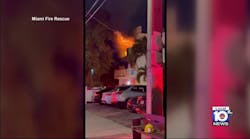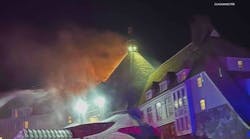In order to prepare for a fire in these massive homes, you have to know what resources are available and what is needed.
When we train on strategy and tactics for the fire in a single-family home, most of us think of the average home. A one- or two-story, 1,400- to 2,200-square-foot structure would probably describe most of the homes to which we respond. The standards outlined in NFPA 1710 and 1720 are geared toward this type of home.
In many areas across the country, however, we find the not-so-average homes. These expansive -- and expensive -- dwellings have become more common as a result of lightweight construction practices. With the non-typical home comes non-typical hazards.
The first issue with a fire in a large home --larger than 4,000 square feet -- is the sheer size of the structure. More rooms, larger rooms, and unusual layouts can easily contribute to the level of difficulty. If we are called to a 2,000-square-foot ranch, it's not that difficult to figure how the home is laid out (garage on one end, bedrooms on the other, kitchen and living areas in between). That is simply not the case in a large home.
Some say, "OK, then treat it like a commercial fire." There are several tactics we use at commercial fires that certainly have a place in a large home fire. Primarily, this would involve a heavier-than-normal first alarm assignment. If we are meeting the staffing requirements of NFPA 1710 or 1720 for fires in single-family dwellings, we are still vastly understaffed for a working fire in a home of this size. Go ugly early in terms of requesting additional units or mutual aid requests.
In addition to the need for more personnel to fight the fire, rapid intervention personnel should be at the ready. The diligent implementation of an effective accountability system is also a must.
Hoselines & Water Supply
Pre-connected crosslays may also be of limited use in this scenario. Depending on the setback and apparatus placement, a 200-foot first-out line may not even get you to the second floor of a 12,000-square-foot starter mansion. It's best to figure out ahead of time that your bread-and-butter stretch won't work. Also, don't forget the adage, "big fire, big water." Light smoke showing from a large home may not indicate the same size fire as light smoke from the average sized home.
The biggest risk to treating a large home fire just like a commercial fire is that the codes applied to the single-family dwelling are much less restrictive, and there is typically no ongoing inspection process.
Water supply may also be a concern, even in areas with adequate fire hydrants. Most of us feel relatively comfortable when we arrive to find a "blue top" hydrant in the front yard, but 1,500 gallon per minute hydrant will only go so far in defensive operations with multiple master streams. What does your city require of the developer, in terms of hydrant flows, when new subdivisions are built? Five hundred gallons per minute? A thousand? Minimum required hydrant flows should be capable of providing the water needed to handle fires in the homes they are put in place to protect.
Expect The Unexpected
We have found several features in these types of homes, if not for luck and preparation, that could have spelled disaster. Elevators and elevator shafts, which one would not think of being in a single-family dwelling, are becoming more commonplace. Doors that lead to these shafts look just like any other interior door. They aren't supposed to open unless the elevator car is on that floor, just like commercial applications. But that's not always the case, especially for an excited firefighter with a set of irons in thier hands.
At one fire, crew on the third floor of a 10,000-square-foot home were working to pull ceilings and gain access to an attic fire caused by lightning. Visibility was low due to smoke and steam, with the main body of fire being over the large media room that made up most of the third floor. Four doors were found around this room. The first three opened led to a bathroom, an adjacent sitting/TV room, and a storage area. The fourth door, when opened, revealed a drop in excess of 20 feet. It was the elevator shaft and the elevator car was in the basement.
Another recent fire revealed a concrete dome located inside the two-story open foyer. The dome supported a 1,200 pound chandelier. Given the fact that the fire was in the attic, this presented a greater-than-normal risk. Fire impinging on the wooden support structure could have, and eventually did, lead to a major collapse in this area. This house also had extremely high ceilings throughout, some of which were covered with a stucco-like finish. This made the typical methods of pulling ceiling rather useless.
The only way to prepare for these types of hazards is to get out of the station, see what's going on in your district, and "fight the fire before the fire." Once you find these challenges and develop potential solutions, you've got to communicate these ideas to all involved parties.
Related Articles
BRIAN COLLINS currently serves as a volunteer firefighter/paramedic with the Pleasant View Volunteer Fire Department, and a career engineer/paramedic with the Brentwood Fire Department, both in Tennessee. He holds a bachelor's degree in fire protection administration from Eastern Kentucky University. Brian also works with the International Society of Fire Service Instructors (ISFSI) and Fire Team USA. To read Brian's complete biography and view his archived articles, click here. You can reach Brian by e-mail at: [email protected].






